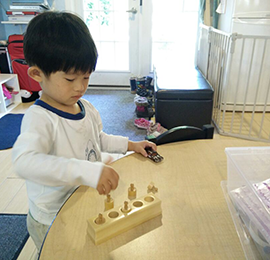AVESPHILOSOPHYOF TEACHING
Aves philosophy is derived from three world-renowned educational approaches to learning: Montessori, Reggio Emilia, and Tools of the Mind. To learn more about each of these approaches, please click below
Montessori

Italy's first female physician, Maria Montessori, created the famous Montessori approach to educating early learners.
Her methodology was born during a time when children were mistreated, as her quote illustrates:
"It was January 6th (1907), when the first school was opened for small, normal children of between three and six years of age. I cannot say on my methods, for these did not yet exist. But in the school that was opened my method was shortly to come into being. On that day there was nothing to be seen but about fifty wretchedly poor children, rough and shy in manner, many of them crying, almost all the children of illiterate parents, who had been entrusted to my care"... "They were tearful, frightened children, so shy that it was impossible to get them to speak; their faces were expressionless, with bewildered eyes as though they had never seen anything in their lives."... "It would be interesting to know the original circumstances that enabled these children to undergo such an extraordinary transformation, or rather, that brought about the appearance of new children, whose souls revealed themselves with such radiance as to spread a light through the whole world."
Quote Reference: www.montessori-ami.org
Maria Montessori saw the child as a unique individual with an innate passion for learning. She believed that with a properly prepared environment, children would be able to develop concentration, self-confidence, and inner discipline at their own pace. Thus, from a Montessori perspective, the environment plays a central role to a child's growth and development. Maria Montessori advocated the environment should be beautiful, orderly, realistic, simple and accessible to young children. Aves' environment has been carefully designed to be exactly this. Our aesthetic classroom is organized such that early learners are able to access materials and equipment easily and independently. Moreover, children are provided with Montessori educational materials as well as other high-quality research-based materials to develop essential cognitive skills. Aves prepared environment allows early learners the opportunity to take responsibility for their own education, and become independent, self-disciplined individuals.
Reggio Emilia

The Reggio Emilia approach to educating early learners is inspired by the famous primary educator, Loris Malaguzzi. His work has greatly influenced the curriculum of early childhood education centres all over the world.
Unlike traditional teacher-directed approaches to learning, the Reggio Emilia approach has a unique perspective on the relationships between teacher, child, parent, and environment.
In this approach, children are viewed as researchers and active constructors of knowledge. Indeed, the idea of "Emergent Curriculum" stems from the idea that children should take an active part in constructing their own curriculum. To support an emergent curriculum, teachers are viewed as collaborators and co-learners of children. They act as facilitators, guiding and encouraging children to hypothesize, experiment, and discover their environment rather than simply providing answers to their inquiries. In Reggio Emilia schools, teachers follow children's interests and use them to inspire children to learn more about the world around them.
The environment also plays an important role in the Reggio Emilia approach to educating early learners. Indeed, the environment is considered to be the "third teacher" of the child (with parents being the first and teachers being the second). How the environment looks, how it is organized, and what it contains sends a message to the children as to whether or not they are valued and respected.
Lastly, documentation is a key component to the Reggio Emilia approach. It comes in many forms such as photographs, written observations, examples of children's work, sketches of children's theories etc., and is used as a communication tool with parents, children, and the community. Parents use documentation as a means of understanding what their child is learning at school, while teachers use documentation as a means of understanding children's theories and how they think. Children use documentation as a means of reflecting on their work and ideas.
At Aves, our modules Strategic Thinking, Creative Corner, Parent Blog, Art Displays, and carefully designed environment stem from the Reggio Emilia Philosophy.
Tools of the Mind

Tools of the Mind is an evidence-based program developed by educational psychologists Bodrova and Leong
The program was informed by the works of Russian psychologist Lev Vygotsky, who had a unique perspective on children's psychological development, often referred to as Cultural-Historical Theory (1978). His theory posits that culture and learning are inseparable, and that the "deep determinants of human activity, consciousness, and personality lie in the historically developing culture, embodied in various sign and symbol systems" (Davydov, 1995, p. 15). Research investigating the effects Tools of the Mind has found that it is a unique program that promotes children's self-regulation development.
What is self-regulation and why is it important?
Self-regulation is the ability to control one's cognitive systems. This includes the ability "to control attention, to direct and monitor thinking and problem solving, and to engage in independent learning activities" (Bronson, 2000, p. 3). The development of self-regulation begins early in life, takes place over an extended time period, and requires substantial external support. The early childhood period is crucial because it is during this time that the brain undergoes a period of maximum plasticity, which is the ability for the brain to change structurally and functionally as a result of input from the environment. Changes that are made to the brain during this time set the stage for later life. Thus, knowing how to support self-regulation during this period is of utmost importance.
Through in-depth research of this program, our Head Teacher has incorporated strategies the Tools of the Mind program employs to help children develop self-regulation into the Aves curriculum. This includes the module Strategic Thinking, and activities such as Buddy Reading, Pattern Movement Game, and Play Planning.
Aves Philosophy

After careful research and practical experience with each of these educational approaches, our Head Teacher has found a common strength each approach advocates when teaching early learners:
Make learning meaningful to children.
You might wonder, what does this actually entail?
Consider the following example below:
Look at the picture:

What is this? Does anybody know?
This is the letter "A".
Apple starts with A.
Alligator starts with A.
What else starts with the letter "A"? Can you tell me?
Now let's practice writing the letter A!
Sound familiar? This may have been how you started learning the alphabet. Yet, when taught in this way, the alphabet is learned truly by memorization. This requires a lot of drill work, which is often boring for children. Not only that, but we often forget that letters and numbers are symbols. They carry meaning because we have attached our own stories to them. However, when children are first introduced to letters and numbers, they see lines on a piece of paper. These letters and numbers carry little to no meaning, just like the Latin letter A shown above might carry no meaning to you. I have no doubt that you can memorize the above letter through practice and drilling, but would you enjoy it? How long would it take? Would you remember the name, sound, and orientation of the letter? How about doing that for each letter of the Latin alphabet pictured below?

This is the scenario that children are so often faced with in early learning environments – having to learn symbols such as letters and numbers through drill work and memorization. Overall, there is very little meaning attached to these abstract concepts.
There is a better way – A fun way, to learn this foundational symbolic information. It involves storytelling because children love listening to stories. Through fun, relatable tales, symbols can be given life. In doing so, children learn that letters and numbers have meaning, making it not only easy for them to remember, but motivated to do so because it is fun!
Aves' students are taught to read using the phenomenal program, Fun Family Phonics (to learn more, please visit www.funfamilyphonics.com). This program falls in line with our philosophy of making learning meaningful to children. In addition, Aves' students are taught foundational math concepts using Meaningful Math, a program developed by the Head Teacher at Aves' that capitalizes on this simple philosophy.
Learning letters and numbers is just a small fraction of what children experience at Aves'. Friendship building, cooperative learning, teamwork skills, strategic thinking, social-emotional competence, problem solving, and conflict resolution are just some of the skills children learn and experience through our program as well. All of these skills are taught following our simple philosophy of making learning meaningful to children. You can learn more about our curriculum by clicking here.